General is a side brand created by Fujitsu General Limited. A Japanese original that manufactures and markets humidity control solutions, and air conditioning units. With manufacturing units in Thailand and India, the company is set to offer you a general section of units that can help you get the job done.
General window air conditioners were a powerhouse and made a name for themselves. Making general a household brand that was commonly found in every other home. With the power to control the thermostat, it came with a powerful system that backed its name. However, there were times when the General air conditioner did not perform up to its potential, an issue that was commonly seen after an error in the system.
To help you out we have listed down some of the most common error codes for Fujitsu General ACs. Start by noting down the error code, and match it using the list below. Once you have the error code you can easily work your way to the fix. Rather than spending hours and spending hundreds trying to figure out what is wrong with your General AC unit.
Mini Split Codes
| Error Codes | Meaning |
|---|---|
| 01 | Indoor unit doesn’t accept signal from outdoor unit |
| 02 | Room temperature sensor open |
| 03 | Room temperature sensor short-circuited |
| 04 | Indoor heat exchanger temperature sensor open |
| 05 | Indoor heat exchanger temperature sensor short circuited |
| 06 | Outdoor heat exchanger temperature sensor |
| 08 | Power source connection error |
| 09 | Float switch operated |
| 0A | Outdoor temperature sensor error |
| 0c | Discharge pipe temperature sensor |
| 11 | Model abnormal/Indoor EPROM Abnormal |
| 12 | Indoor fan abnormal |
| 13 | Outdoor unit doesn’t accept the signal from indoor unit |
| 14 | Excessive outdoor pressure (permanent stop) |
| 15 | Compressor temperature sensor |
| 16 | Pressure switch error |
| 17 | IPM error |
| 18 | CT error |
| 19 | Active filter module (AFM) error |
| 1A | Compressor does not operate |
| 1b | Outdoor unit fan error |
| 1c | Communication error (inverter to multi controller) |
| 1d | 2 way valve sensor error |
| 1E | Expansion valve error |
| 1F | Connection indoor unit error |
LED Flash Error Contents
| Flashing | Problem |
|---|---|
| 1 flash | Communication error (Indoor unit to Outdoor unit) |
| 2 flash | Discharge pipe temperature sensor |
| 3 flash | Outdoor heat exchanger temperature sensor |
| 4 flash | Outdoor temperature sensor |
| 7 flash | Compressor temperature sensor |
| 8 flash | Heat sink temperature sensor |
| 9 flash | Pressure switch abnormal |
| 12 flash | IPM error |
| 13 flash | Compressor rotor position cannot detect |
| 14 flash | Compressor cannot operate/Start up error |
| 15 flash | Outdor fan abnormal (upper fan) |
| 16 flash | Outdoor fan abnormal (lower fan) |
Outdoor Unit Display Codes
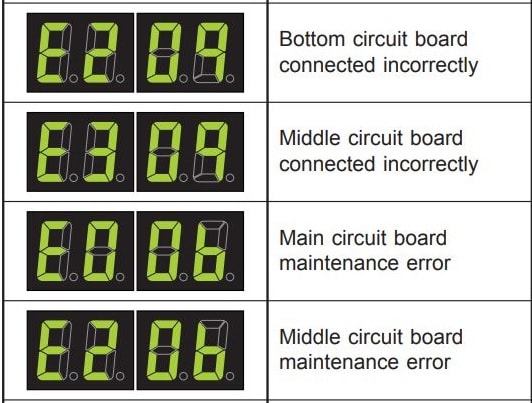
| Error Codes | Cause |
|---|---|
| 11 | Outdoor communication signal error (Forward transfer signal error) |
| 8 | Outdoor discharge pipe temperature thermistor error |
| 5 | Outdoor heat exchanger temperature thermistor error |
| 7 | Outdoor temperature thermistor error |
| 21 | 2-way valve temperature thermistor error |
| 22 | 3-way valve temperature thermistor error |
| 12 | Compressor temperature thermistor error |
| 19 | Heat sink temperature thermistor error |
| 13 | Pressure switch error |
| 23 | Connected indoor unit error |
| 14 | IPM error |
| 17 | Compressor rotor location cannot detect(permanent stop) |
| 20 | Compressor Start-up error (permanent stop) |
| 18 | Outdoor unit fan motor error |
| 24 | Main CPU - sub CPU communication error |
| 32 | 4-way valve error |
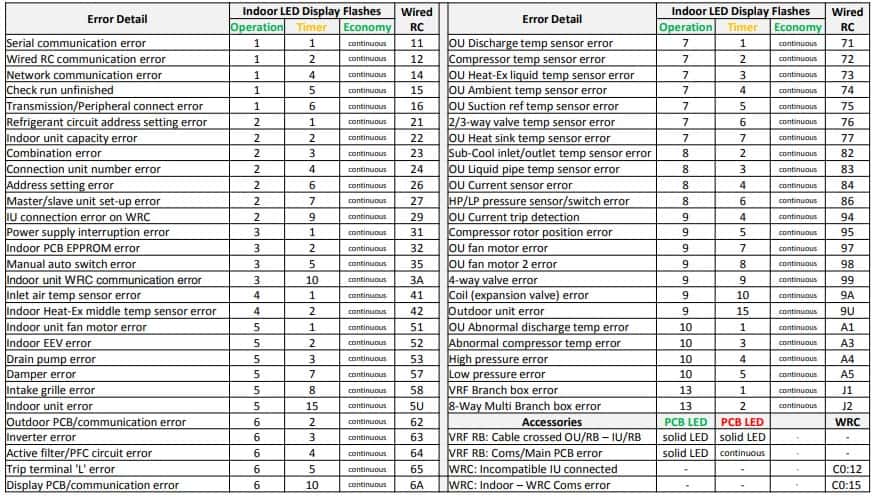
Wired Remote Controller Codes List
| Error Codes | Problem |
|---|---|
| 00 | No error |
| 02 | Model information abnormal |
| 04 | Power supply frequency abnormal |
| 06 | EEPROM access error |
| 07 | EEPROM deletion error |
| 09 | Room temperature themistor error |
| 0A | Indoor unit heat exchanger themistor (middle) error |
| 0b | Indoor unit heat exchanger themistor (inlet) error |
| 0C | Indoor unit heat exchanger themistor (outlet) error |
| 0d | Blower temperature themistor error |
| 11 | Drain abnormal |
| 12 | Room temperature abnormal |
| 13 | Indoor unit fan error |
| 1F | Transmission error |
| 20 | Node setting error |
| 21 | Parallel communication error |
| 32 | Outdoor unit error |
| 35 | Manual auto switch error |
| 41 | Room error |
| 42 | Indoor unit Heat Ex. sensor error |
| 51 | Indoor unit fan motor error |
| 53 | Water Drain error |
| 50 | Indoor unit error |
| 62 | Outdoor unit main PCB error |
| 63 | Inverter PCB error |
| 65 | IPM error |
| 71 | Discharge thermistor error |
| 86 | Pressure sensor error |
| 97 | Outdoor unitfan motor1 error |
| A1 | Discharge temperature 1 error |
| A3 | Compressor temperature error |
| A5 | Pressure error 2 |
| J2 | Unit flow divider error |
Troubleshooting
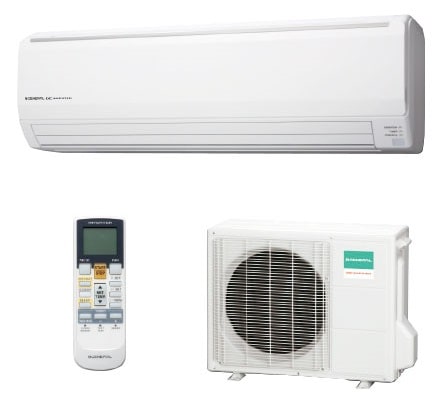
In the event of a malfunction (burning smell, etc.), immediately stop operation, turn off the electrical breaker and consult authorized service personnel. Merely turning off the unit’s power switch will not completely disconnect the unit from the power source. Always be sure to turn off the electrical breaker to ensure that power is completely off.
Before requesting service, perform the following checks:
Symptom: Doesn’t operate immediately:
Problem:
- If the indoor unit is stopped and then immediately started again, the compressor will not operate for about 3 minutes, in order to prevent fuse blowouts.
- Whenever the electrical breaker is turned off then on again the protection circuit will operate for about 3 minutes, preventing unit operation during that period.
Symptom: Noise is heard
Problem:
- During operation or immediately after stopping the unit, the sound of water fl owing in the air conditioner’s piping may be heard. Also, noise may be particularly noticeable for about 2 to 3 minutes after starting operation (sound of refrigerant fl owing).
- During operation, a slight squeaking sound may be heard. This is the result of minute expansion and contraction of the front panel due to temperature changes.
- During Heating operation, a sizzling sound may be heard occasional. This sound is produced by the Automatic Defrosting operation.
Symptom: Smells
Problem: Some smell may be emitted from the indoor unit. This smell is the result of room smells (furniture, tobacco, etc.) which have been taken into the indoor unit.
If the problem persists after performing these checks, or if you notice burning smells, or the OPERATION Indicator Lamp and the TIMER Indicator Lamp flashes, and ECONOMY Indicator Lamp flashes fast. Immediately stop operation, turn off the electrical breaker and consult authorized service personnel.
Remote Control Meaning
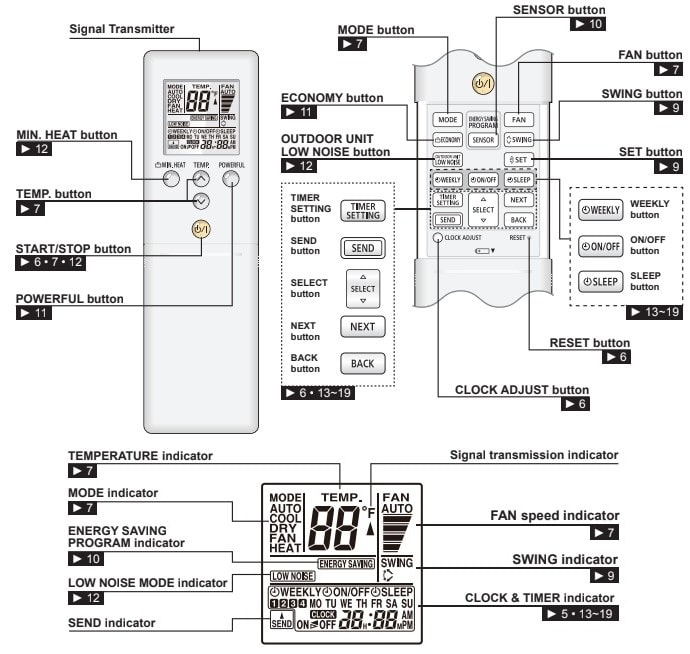
Manual Pdf
source: www.fujitsugeneral.com
- Unionaire Air Conditioner Error Codes - December 1, 2025
- Ameristar AC Error Codes and Troubleshooting - December 1, 2025
- Rheem Pool Heat Pump Error Codes - December 1, 2025

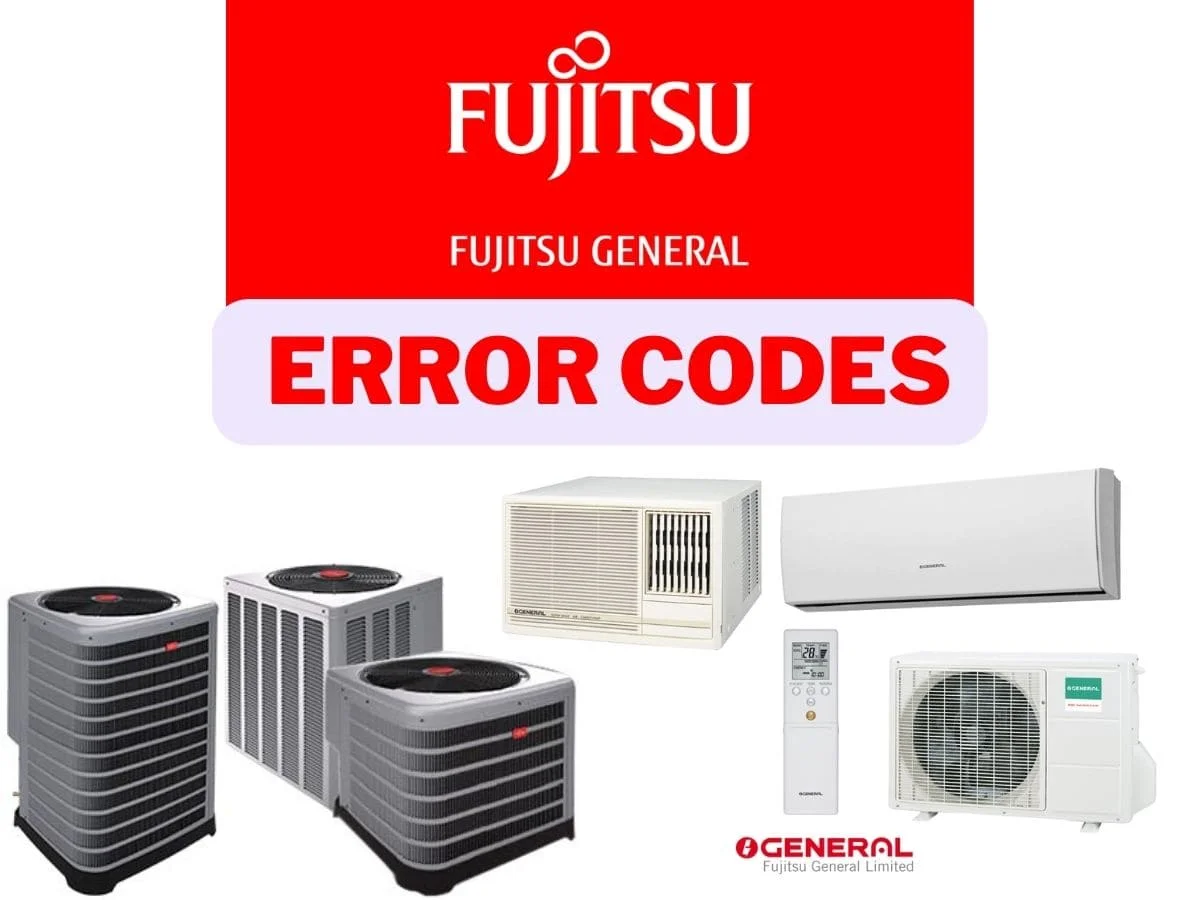
o general indoor unit ml. ASGA18FUTC-B operation 5time and timer light 1 time flash
I have a Fujitsu split A.C. system that was installed in Oct 2017. Recently the inside units have quit working and flash a 10 1 code. A hard reset of the compressor fixes the problem temporarily, but the issue soon returns. Any info or advice?
Hi,
I am having an issue that my below product compressor is not working.
Product: O GENERAL ASGA18JCC 1.5 TON INVERTER SPLIT AC
Model No: ASGA18JCC 1.5 ton
The timer light blinks two times and the technical person also said that the error code is 02. But the problem is that he is saying that the PCB will be replaced while the list says that it is an indoor unit thermostat error.
What could be the possibilities for fixing these errors?
Thanks
Sudhir
o genral duct ac unit run after autometic indoor outdoor off th displey gone power is ok what problem